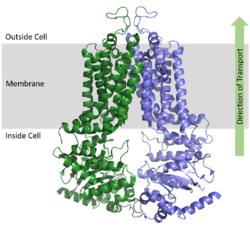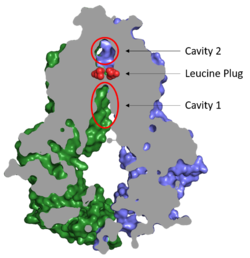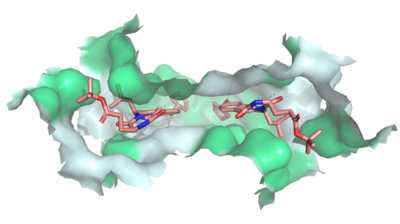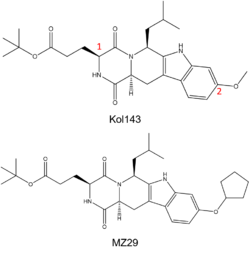Sandbox Reserved 1620
From Proteopedia
(Difference between revisions)
| Line 34: | Line 34: | ||
==Disease== | ==Disease== | ||
[[Image:Ligand_Interactions_6ffc.png|400 px|right|thumb|Figure 3: MZ29 bound to cavity 1 of ABCG2 [https://www.rcsb.org/structure/6FFC (6FFC)]. Two MZ29 are shown in sticks and are colored by element. Hydrophobic interactions between the surface of cavity 1 and MZ29 are shown in green.]] | [[Image:Ligand_Interactions_6ffc.png|400 px|right|thumb|Figure 3: MZ29 bound to cavity 1 of ABCG2 [https://www.rcsb.org/structure/6FFC (6FFC)]. Two MZ29 are shown in sticks and are colored by element. Hydrophobic interactions between the surface of cavity 1 and MZ29 are shown in green.]] | ||
| - | Dysfunctions in ABCG2 are linked to [https://en.wikipedia.org/wiki/Hyperuricemia hyperuricemia] which can lead to [https://en.wikipedia.org/wiki/Gout gout], [https://en.wikipedia.org/wiki/Kidney_disease kidney disease], and [https://en.wikipedia.org/wiki/Hypertension hypertension], all of which are thought to be the result of impaired transport of uric acid. Additionally, the expression of ABCG2 has been found to correlate with a poor prognosis and treatment outcome of various cancers including breast, ovarian, and lung.<ref name="Jackson"/> | + | Dysfunctions in ABCG2 are linked to [https://en.wikipedia.org/wiki/Hyperuricemia hyperuricemia] which can lead to [https://en.wikipedia.org/wiki/Gout gout], [https://en.wikipedia.org/wiki/Kidney_disease kidney disease], and [https://en.wikipedia.org/wiki/Hypertension hypertension], all of which are thought to be the result of impaired transport of uric acid. Additionally, the expression of ABCG2 has been found to correlate with a poor prognosis and treatment outcome of various cancers including breast, ovarian, and lung.<ref name="Jackson">PMID:29610494</ref> |
Several mutations also decrease transporter activity.<ref name="Taylor"/><ref name="Manolaridis"/><ref name="Robey"/> The most detrimental of these is a point mutation of <scene name='83/832939/Residue_211/1'>Glu211 to Gln211</scene> , which completely abolished activity of the transporter. Another point mutation occurs <scene name='83/832939/The_cause_of_gout/1'>at Gln141</scene>, which when mutated to lysine causes gout by distorting ABCG2's tertiary structure. Changes at <scene name='83/832939/R482/1'>Arg482</scene> shift the substrate specificity of ABCG2 by [https://en.wikipedia.org/wiki/Allosteric_regulation allosteric effects] as this residue is distantly located from the binding pocket. | Several mutations also decrease transporter activity.<ref name="Taylor"/><ref name="Manolaridis"/><ref name="Robey"/> The most detrimental of these is a point mutation of <scene name='83/832939/Residue_211/1'>Glu211 to Gln211</scene> , which completely abolished activity of the transporter. Another point mutation occurs <scene name='83/832939/The_cause_of_gout/1'>at Gln141</scene>, which when mutated to lysine causes gout by distorting ABCG2's tertiary structure. Changes at <scene name='83/832939/R482/1'>Arg482</scene> shift the substrate specificity of ABCG2 by [https://en.wikipedia.org/wiki/Allosteric_regulation allosteric effects] as this residue is distantly located from the binding pocket. | ||
Current revision
ABCG2 Multidrug Transporter
References
- ↑ 1.0 1.1 1.2 1.3 1.4 1.5 1.6 Taylor NMI, Manolaridis I, Jackson SM, Kowal J, Stahlberg H, Locher KP. Structure of the human multidrug transporter ABCG2. Nature. 2017 Jun 22;546(7659):504-509. doi: 10.1038/nature22345. Epub 2017 May, 29. PMID:28554189 doi:http://dx.doi.org/10.1038/nature22345
- ↑ 2.0 2.1 2.2 2.3 2.4 2.5 2.6 2.7 2.8 Manolaridis I, Jackson SM, Taylor NMI, Kowal J, Stahlberg H, Locher KP. Cryo-EM structures of a human ABCG2 mutant trapped in ATP-bound and substrate-bound states. Nature. 2018 Nov;563(7731):426-430. doi: 10.1038/s41586-018-0680-3. Epub 2018 Nov, 7. PMID:30405239 doi:http://dx.doi.org/10.1038/s41586-018-0680-3
- ↑ 3.0 3.1 3.2 3.3 Robey RW, Pluchino KM, Hall MD, Fojo AT, Bates SE, Gottesman MM. Revisiting the role of ABC transporters in multidrug-resistant cancer. Nat Rev Cancer. 2018 Jul;18(7):452-464. doi: 10.1038/s41568-018-0005-8. PMID:29643473 doi:http://dx.doi.org/10.1038/s41568-018-0005-8
- ↑ 4.0 4.1 4.2 Jackson SM, Manolaridis I, Kowal J, Zechner M, Taylor NMI, Bause M, Bauer S, Bartholomaeus R, Bernhardt G, Koenig B, Buschauer A, Stahlberg H, Altmann KH, Locher KP. Structural basis of small-molecule inhibition of human multidrug transporter ABCG2. Nat Struct Mol Biol. 2018 Apr;25(4):333-340. doi: 10.1038/s41594-018-0049-1. Epub, 2018 Apr 2. PMID:29610494 doi:http://dx.doi.org/10.1038/s41594-018-0049-1
- ↑ Marzac C, Garrido E, Tang R, Fava F, Hirsch P, De Benedictis C, Corre E, Lapusan S, Lallemand JY, Marie JP, Jacquet E, Legrand O. ATP Binding Cassette transporters associated with chemoresistance: transcriptional profiling in extreme cohorts and their prognostic impact in a cohort of 281 acute myeloid leukemia patients. Haematologica. 2011 Sep;96(9):1293-301. doi: 10.3324/haematol.2010.031823. Epub, 2011 May 23. PMID:21606172 doi:http://dx.doi.org/10.3324/haematol.2010.031823
- ↑ Bartholomae S, Gruhn B, Debatin KM, Zimmermann M, Creutzig U, Reinhardt D, Steinbach D. Coexpression of Multiple ABC-Transporters is Strongly Associated with Treatment Response in Childhood Acute Myeloid Leukemia. Pediatr Blood Cancer. 2016 Feb;63(2):242-7. doi: 10.1002/pbc.25785. Epub 2015 Oct, 29. PMID:26512967 doi:http://dx.doi.org/10.1002/pbc.25785
- ↑ Mohelnikova-Duchonova B, Brynychova V, Oliverius M, Honsova E, Kala Z, Muckova K, Soucek P. Differences in transcript levels of ABC transporters between pancreatic adenocarcinoma and nonneoplastic tissues. Pancreas. 2013 May;42(4):707-16. doi: 10.1097/MPA.0b013e318279b861. PMID:23462326 doi:http://dx.doi.org/10.1097/MPA.0b013e318279b861
- ↑ Mao Q, Unadkat JD. Role of the breast cancer resistance protein (BCRP/ABCG2) in drug transport--an update. AAPS J. 2015 Jan;17(1):65-82. doi: 10.1208/s12248-014-9668-6. Epub 2014 Sep 19. PMID:25236865 doi:http://dx.doi.org/10.1208/s12248-014-9668-6
- ↑ Leonard GD, Fojo T, Bates SE. The role of ABC transporters in clinical practice. Oncologist. 2003;8(5):411-24. doi: 10.1634/theoncologist.8-5-411. PMID:14530494 doi:http://dx.doi.org/10.1634/theoncologist.8-5-411
- ↑ Binkhathlan Z, Lavasanifar A. P-glycoprotein inhibition as a therapeutic approach for overcoming multidrug resistance in cancer: current status and future perspectives. Curr Cancer Drug Targets. 2013 Mar;13(3):326-46. doi:, 10.2174/15680096113139990076. PMID:23369096 doi:http://dx.doi.org/10.2174/15680096113139990076
- ↑ Witherspoon SM, Emerson DL, Kerr BM, Lloyd TL, Dalton WS, Wissel PS. Flow cytometric assay of modulation of P-glycoprotein function in whole blood by the multidrug resistance inhibitor GG918. Clin Cancer Res. 1996 Jan;2(1):7-12. PMID:9816083
- ↑ Allen JD, van Loevezijn A, Lakhai JM, van der Valk M, van Tellingen O, Reid G, Schellens JH, Koomen GJ, Schinkel AH. Potent and specific inhibition of the breast cancer resistance protein multidrug transporter in vitro and in mouse intestine by a novel analogue of fumitremorgin C. Mol Cancer Ther. 2002 Apr;1(6):417-25. PMID:12477054
- ↑ Weidner LD, Zoghbi SS, Lu S, Shukla S, Ambudkar SV, Pike VW, Mulder J, Gottesman MM, Innis RB, Hall MD. The Inhibitor Ko143 Is Not Specific for ABCG2. J Pharmacol Exp Ther. 2015 Sep;354(3):384-93. doi: 10.1124/jpet.115.225482. Epub , 2015 Jul 6. PMID:26148857 doi:http://dx.doi.org/10.1124/jpet.115.225482
Student Contributors
Julia Pomeroy
Shelby Skaggs
Sam Sullivan
Jaelyn Voyles




